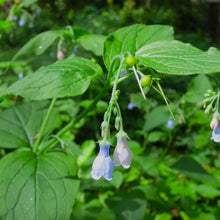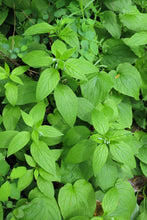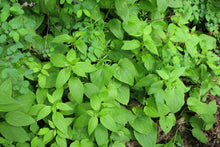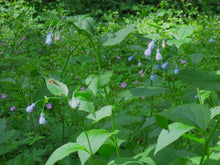
Mertensia subcordata (aka/formerly Mertensia platyphylla)
Western bluebells, also known as broadleaf bluebells, is a charming wildflower often found in moist, shady spots such as meadows and woodland edges, making it a valuable addition to a woodland or natural shade gardens. In spring, it produces striking clusters of bell-shaped, vibrant blue flowers that dangle gracefully from tall stems, set against broad, oval-shaped leaves that emerge fresh and bright green. As the seasons progress, the foliage transitions to a rich, deep green while the flowers fade and the plant eventually dies back entirely. Beyond its beauty, western bluebells play an important role in supporting pollinators, particularly bees, butterflies and hummingbirds, while its dense foliage helps retain moisture and stabilize soil.
- Plant type/canopy layer: deciduous, perennial, herbaceous plant
- Size at maturity: 12-36” tall; individual plants 12” wide, but spread laterally by rhizomes
- Light requirements: full shade
- Moisture requirements: moist soil
- Bloom time: April-June
- Growth rate/ease: fast growing, easy to grow
- Wildlife support: flowers attract bees, especially bumblebees, and butterflies such as swallowtails and fritillaries, which feed on nectar; seeds are a food source for small birds, including species like juncos and sparrows, in late summer and fall; overall plant is host and larval food source for several species of native butterflies and moths and provides cover for small mammals, while offering protection for ground-dwelling insects
- Native habitat/range: found along streambanks, moist to wet woods and damp thickets, from sea level to 1000 meters, in Oregon and Washington, from the west of the Cascades to the Coast Mountains. Portland Plant List - yes.
- Special features & uses: groundcover; deer resistant; landscape uses include woodland gardens, shady raingardens and erosion control
Gardening with Western Bluebells: This lovely perennial will bring a touch of elegance and color to shaded or partially shaded areas of your habitat garden. It thrives in moist, well-drained soils, particularly in locations that mimic its natural mountain habitat. Preferring dappled sunlight or light shade, it is ideal for planting beneath taller trees, along woodland edges, or in a sheltered corner of the garden, where it will help retain soil moisture, suppress weeds, and support pollinators. Be sure to provide supplemental water (deeply/infrequently) if planted in drier areas of the garden.
Photo Credits (flowers, flowering population, non-flowering population, foliage): © Ed Alverson, some rights reserved (CC-BY)







